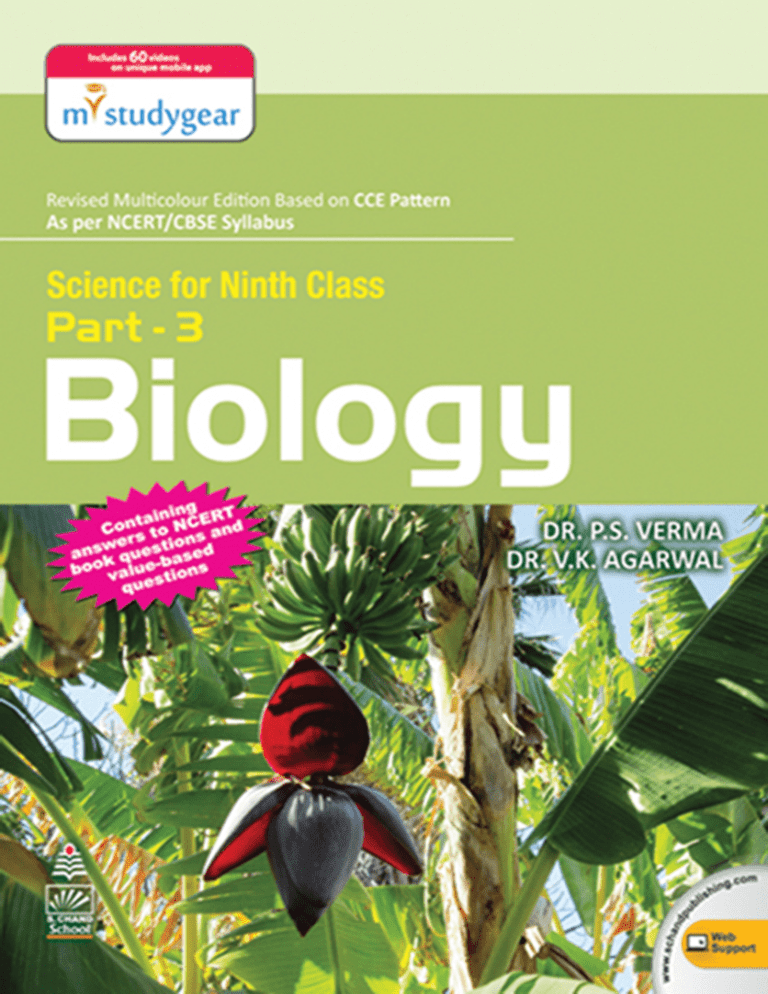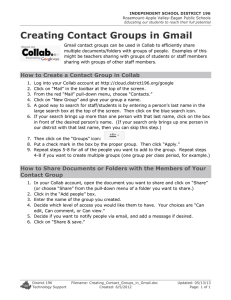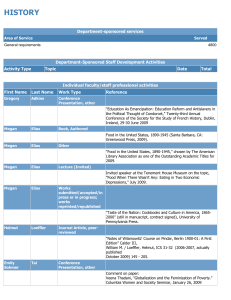
This book has been revised according to the CCE pattern of school education based on
NCERT syllabus prescribed by the Central Board of Secondary Education (CBSE) for Class IX
Science for Ninth Class
(PART – 3)
BIOLOGY
As per NCERT/CBSE Syllabus
(Based on CCE Pattern of School Education)
Dr. P.S. VERMA
M.Sc., Ph.D., F.E.S.I., F.A.Z.
Dr. V.K. AGARWAL
M.Sc., Ph.D.
Reader (Retd.)
Reader and Head (Retd.)
Department of Zoology
Meerut College
MEERUT
This Book Belongs to :
Name................................................................................ Roll No.............................................................................. Class...................................Section................................
School............................................................................... Value Based
Questions
(with answers)
S. CHAND SCHOOL BOOKS
(An imprint of S. Chand Publishing)
A Division of S. Chand And Company Pvt. Ltd.
(An ISO 9001 : 2008 Company)
7361, Ram Nagar, Qutab Road, New Delhi-110055
Phone: 23672080-81-82, 9899107446, 9911310888; Fax: 91-11-23677446
www.schandpublishing.com; e-mail : helpdesk@schandpublishing.com
Branches :
Ahmedabad Bengaluru Bhopal Chandigarh
Chennai Coimbatore Cuttack Dehradun Guwahati Hyderabad Jaipur Jalandhar Kochi Kolkata Lucknow Mumbai Nagpur Patna Pune Raipur Ranchi Siliguri Visakhapatnam
: Ph: 27541965, 27542369, ahmedabad@schandpublishing.com
: Ph: 22268048, 22354008, bangalore@schandpublishing.com
: Ph: 4274723, 4209587, bhopal@schandpublishing.com
: Ph: 2725443, 2725446, chandigarh@schandpublishing.com
: Ph: 28410027, 28410058, chennai@schandpublishing.com
: Ph: 2323620, 4217136, coimbatore@schandpublishing.com (Marketing Office)
: Ph: 2332580; 2332581, cuttack@schandpublishing.com
: Ph: 2711101, 2710861, dehradun@schandpublishing.com
: Ph: 2738811, 2735640, guwahati@schandpublishing.com
: Ph: 27550194, 27550195, hyderabad@schandpublishing.com
: Ph: 2219175, 2219176, jaipur@schandpublishing.com
: Ph: 2401630, 5000630, jalandhar@schandpublishing.com
: Ph: 2378740, 2378207-08, cochin@schandpublishing.com
: Ph: 22367459, 22373914, kolkata@schandpublishing.com
: Ph: 4026791, 4065646, lucknow@schandpublishing.com
: Ph: 22690881, 22610885, mumbai@schandpublishing.com
: Ph: 6451311, 2720523, 2777666, nagpur@schandpublishing.com
: Ph: 2300489, 2302100, patna@schandpublishing.com
: Ph: 64017298, pune@schandpublishing.com
: Ph: 2443142, raipur@schandpublishing.com (Marketing Office)
: Ph: 2361178, ranchi@schandpublishing.com
: Ph: 2520750, siliguri@schandpublishing.com (Marketing Office)
: Ph: 2782609, visakhapatnam@schandpublishing.com (Marketing Office)
© 1980, Lakhmir Singh & Manjit Kaur
All rights reserved. No part of this publication may be reproduced or copied in any material form (including photocopying or storing it in any medium in form of graphics,
electronic or mechanical means and whether or not transient or incidental to some other use of this publication) without written permission of the publisher. Any breach
of this will entail legal action and prosecution without further notice.
Jurisdiction : All disputes with respect to this publication shall be subject to the jurisdiction of the Courts, Tribunals and Forums of New Delhi, India only.
S. CHAND’S Seal of Trust
In our endeavour to protect you against counterfeit/fake books, we have pasted a holographic film over the cover of this book.
The hologram displays the unique 3D multi-level, multi-colour effects of our logo from different angles when tilted or properly
illuminated under a single source of light, such as 2D/3D depth effect, kinetic effect, gradient effect, trailing effect, emboss effect,
glitter effect, randomly sparkling tiny dots, etc.
A fake hologram does not display all these effects.
First Published in 1980
Revised Edition 2014, 2016
Reprints 1981, 82, 83, 84, 86, 89, 90, 92, 93, 94, 95, 96, 97, 98, 99, 2000, 2001, 2002, 2003, 2004, 2005, 2006, 2007, 2008, 2009, 2010, 2011,
2012, 2013, 2015, 2016 (Thrice)
ISBN : 978-93-525-3027-4 Code : 1003G 349 PRINTED IN INDIA
By Vikas Publishing House Pvt. Ltd., Plot 20/4, Site-IV, Industrial Area Sahibabad, Ghaziabad-201010
and Published by S. Chand And Company Pvt. Ltd., 7361, Ram Nagar, New Delhi -110 055.
Biology IX: Lakhmir Singh
PREFACE TO THE REVISED EDITION
We Indians are witnessing a challenging phase of renovation and implementation of revolutionary new
ideas in the development and betterment of our nation. Our National Policy makers are becoming increasingly
global in their attitudes, so there is a whiff of freshness in every walk of life be it Information Technology,
Finance, Education, Health, Sports, Biotechnology or Agriculture. It appears as though we have awakened
from a deep slumber, have recognised our worth and conſdently taking forward steps towards progress and
development of the India. Modern India is marching ahead with new hopes for the masses and downtroddens.
Indeed science has become a channel to provide food, fabric, medicines, bioenergy, healthy environs and new
lease of life to wild biota and protecting abiotic resources of the biosphere. Manoj Prasad recently reported in
the Indian Express (December 3, 2010) on how a septagenarian tribal Mr. Simon Oranon saved rainwater and
jungles with three dams, ſve ponds for yearround irrigation of crop ſelds and planted about 30,000 trees of
sal, jackfruit, jamun and mango (to check the soil erosion). His ingenious social work has changed the lives of
people in six villages of Chottanagpur (Ranchi), Jharkhand State (i.e., Bero, Hariharpur, Jamtoli, Kaxitoli, Baitoli
and Bhasanda villages). The present revised and enlarged multicolour edition of our book “Science for Ninth
Class (Part - 3) Biology” is based on the latest CCE guidelines. The text part of the book is strictly according
to the N.C.E.R.T Textbook. Present revised pruned edition of the book includes the following new features :
1. Text is thoroughly checked, corrected, revised and made tailormade according to speciſc needs of our
students.
2. The Formative Assessment of each chapter is updated according to needs of our readers. In chapter 5,
adequate new ideas for activities, topics for seminars and modus operandi of holding a group discussion,
all have been suggested.
3. A variety of questions, MCQs, etc., of Summative Assessment have been formulated to cover each
chapter more exhaustively.
4. Almost 60 per cent questions of the book have been answered.
5. Chapter 4 of the book, is a bit bloated in volume since it carries entirely renewed Question Bank of
practical related questions.
An attempt has also been made to include questions from the sample papers issued by CBSE Board.
Value Based Questions have been added at the end of each chapter. These questions are based on the
application of Biology in our daily life. Value based questions are meant for inculcating social values amongst
our young students.
Despite of all the major changes introduced in the present edition, we have maintained simplicity and
modernity of the text so as to cater to all types of students including brilliant and outstanding ones.
Thanks and blessings to Ms Anubha Agarwal for painstaking editing and critical review of this book.
Our sincere thanks are extended to the management, editorial and DTP team of S. Chand & Company
Ltd. Their tireless efforts remained quite crucial in timely release of this book.
Hope, our this endeavour will help I: class students of India and ſre their imagination to learn more and
more about the nature.
We welcome constructive criticism and healthy suggestions from our readers for the betterment of the book.
Meerut (U.P.)
AUTHORS
DISCLAIMER
While the authors of this book have made every effort to avoid any mistake or omission and have used their skill, expertise and knowledge to the
best of their capacity to provide accurate and updated information, the authors and the publisher do not give any representation or warranty with
respect to the accuracy or completeness of the contents of this publication and are selling this publication on the condition and understanding that
they shall not be made liable in any manner whatsoever. The publisher and the authors expressly disclaim all and any liability/responsibility to any
person, whether a purchaser or reader of this publication or not, in respect of anything and everything forming part of the contents of this publication.
The publisher and authors shall not be responsible for any errors, omissions or damages arising out of the use of the information contained in this
publication. Further, the appearance of the personal name, location, place and incidence, if any; in the illustrations used herein is purely coincidental
and work of imagination. Thus the same should in no manner be termed as defamatory to any individual.
CONTINUOUS AND COMPREHENSIVE EVALUATION (CCE)
SCHEME
For Term–I & Term –II
April to March
PROPOSED EVALUATION SCHEME FOR VARIOUS SUBJECTS
x
x
x
x
7KHXQLWVVSHFL¿HGIRUHDFKWHUPVKDOOEHDVVHVVHGWKURXJKERWK)RUPDWLYHDQG6XPPDWLYH$VVHVVPHQW
The students will be assessed by CCE in the school itself.
&&(RYHURQHDFDGHPLF\HDUZLOOKDYHWZRWHUPV$SULO6HSWHPEHUDQG2FWREHU0DUFK
Each term will have two formative and one summative assessment.
There will be two formative tests and a term end summative test. The weightages and time schedule will be as under:
SEMESTER–I/TERM-I
Type of Test
)RUPDWLYH$VVHVVPHQW
)RUPDWLYH$VVHVVPHQW
6XPPDWLYH$VVHVVPHQW
Weightage
Time schedule
$SULOWR0D\
-XO\WR$XJ
6HSW
)$)$2 6$ SEMESTER - II/TERM-II
Type of Test
)RUPDWLYH$VVHVVPHQW
)RUPDWLYH$VVHVVPHQW
6XPPDWLYH$VVHVVPHQW
Weightage
Time schedule
2FWWR1RY
-DQWR)HE
0DUFK
)$3)$4 = 6$2 Design of the Question Paper for Summative Assessment
S.No. Type of questions
1.
2.
3.
4
5.
Total
No. of questions
9HU\6KRUW$QVZHU7\SH96$
6KRUW$QVZHU7\SH6$,
6KRUW$QVZHU7\SH,,6$,,
/RQJ$QVZHU7\SH/$
0&43UDFWLFDO6NLOOV
42
Marks allotted
to each question
Total Marks
90
FORMATIVE ASSESSMENT IN SCIENCE INCLUDES :
A. Assessment on Paper-pen test : Due weightage to be given to different types of questions (short answer, long answer, MCQ
HWF7KHTXHVWLRQVVKRXOGLQFOXGHDOOGLI¿FXOW\OHYHOV(DV\$YHUDJH'LI¿FXOWDQG+276
B. Practical assessment based on latest CBSE curriculum would include the following: The students should be asked to
FRQGXFWH[SHULPHQWIURPDOODUHDVRIFXUULFXOP7KHDVVHVVPHQWVVKRXOGEHEDVHGRQWKHIROORZLQJ([SHULPHQWDO6HWXS2EVHUYDWLRQ5HFRUGRIREVHUYDWLRQGDWD$QDO\VLVRIREVHUYDWLRQGDWD&RQFOXVLRQVGUDZQE\WKHVWXGHQW3UDFWLFDO5HFRUG)LOH9LYD
C. Continuous Assessment in the following suggested areas :
(1) Home assignments/class assignments: 'XHZHLJKWDJHWREHJLYHQWR5HJXODULW\1HDWQHVV3UHVHQWDWLRQ&RUUHFWQHVV
(2) Class response may include : 2UDO4XHVWLRQLQJ4XL]:RUNVKHHWV
(iv)
S.No.
Assessment Method
Areas of Assessment
Oral Questioning : 2UDO4XHVWLRQVWRDVVHVVWKH
the understanding of the topic
2.
Quiz :7KH&ODVVVWXGHQWVGLYLGHGLQJURXSVDQG
4XHVWLRQVSHUWDLQLQJWRWKHWRSLFDVNHGWRDVVHVV
WKHVWXGHQWVRIDJURXS
3.
Worksheets :8VHRIZRUNVKHHWVWRDVVHVVWKH
VWXGHQWVLQWKHFODVV
/LVWHQLQJ6NLOOV&ODULW\RIH[SUHVVLRQ&ODULW\RI concepts,
Communication Skills
7KLQNLQJVNLOOV$OWHUWQHVV7LPHPDQDJH
PHQW $SSOLFDWLRQ RI NQRZOHGJH 5HDVRQLQJ VNLOO $UW RI
TXL]]LQJ
&RPSUHKHQVLRQ5HJXODULW\$SSOLFDWLRQRINQRZOHGJH
$WWHQWLYHQHVV
1.
(3) Seminar : $WRSLFPD\EHGLYLGHGDPRQJHLJKWWRWHQVWXGHQWVIRUWKHPWRUHVHDUFKVWXG\DQGµSUHVHQW¶LWWRDOOVWXGHQWVHJ
Topic “Improvement in Crop Yields” can be divided into sub-topics for presentation by the students.
(i) Introduction
(ii) Crop Variety Improvement
(iii) Crop Production Management
(iv) Crop Protection Management
Areas of Assessment : $ELOLW\WRUHVHDUFKRQWKHWRSLF$FTXLVLWLRQRIFRQWHQWNQRZOHGJH3XEOLFVSHDNLQJ9HUEDOH[SUHVVLRQ
ICT skills, Leadership quality
Suggested topics based on the curriculum : $QLPDO+XVEDQGU\'LVHDVHVDQGWKHLUFDXVHV6RXUFHVRIHQHUJ\DQGRYHUFRPLQJHQHUJ\FULVLV$SSOLFDWLRQRI$UFKLPHGH¶V3ULQFLSOH3K\VLFDODQG&KHPLVWU\FKDQJHVLQGDLO\OLIHVHSDUDWLRQRIPL[WXUHV
the techniques.
(4) Symposium : 6WXGHQWVFDQEHDVNHGWRµSUHVHQW¶SDSHUVRQWKHWRSLFVRIWKHLUFKRLFH
Areas of Assessment : Depth of the content, Presentation of the content, Use of audio-visual aids, Expression, Comprehension
of the topic.
Suggested Topics based on the curriculm/related to the curriculum : Hygiene to ward off the diseases. Prevention is better
WKDQFXUH$SSOLFDWLRQRIXOWUDVRXQG3UHVVXUHLWVDSSOLFDWLRQLQGDLO\OLIH&KHPLFDOFODVVL¿FDWLRQRIPHWDOV$WRPLFPRGHOV
(5) Group Discussion : $JURXSRIWHQVWXGHQWVFDQEHJLYHQDWRSLFWRGLVFXVV6WXGHQWVWRFKRRVHWKHLUJURXSOHDGHUDPRGHUDWRU
DQGDUHFRUGHUWKHLUUROHVWREHFODUL¿HG7KHWRSLFWREHWKURZQRSHQIRUGLVFXVVLRQ
Group leader to ensure all students participate in the group discussion.
Moderator to ensure that there is no cross talk and no two students speak together and all listen to one speaker patiently.
Recorder to record the observation made by all students in the group including his/her own.
Areas of Assessment : &RXUDJHWRSXWIRUWKYLHZV7HDP:RUN5HVSHFWWRSHHU.QRZOHGJHRIFRQWHQW$SSURSULDWHERG\
language, Communication kills, Listening skills.
Suggested Topics : Based on curriculum Or related to the curriculum : Global warming and its impact, Role of students
in bringing awareness among community members on : Importance of hygiene, Saving of power and water, Importance of ImPXQL]DWLRQ'LVSODFHPHQWRIDQREMHFWLQWKHDEVHQFHRIDQ\IRUFHDFWLQJRQLW(QHUJ\WUDQVIRUPDWLRQLQGDLO\OLIHVLWXDWLRQV
/DZVRIFKHPLFDOFRPELQDWLRQ$SSOLFDWLRQRI&ROORLGV
(6) Projects : 7KHVWXGHQWVPD\EHDVNHGWRGRWKHLQYHVWLJDWRU\RUH[SHULPHQWDOSURMHFWVDVH[SODLQHGEHORZ
(a) Investigatory Projects include : FROOHFWLRQRIGDWD$QDO\VLV,QWHUSUHWDWLRQRIGDWD2EVHUYDWLRQFRQFOXVLRQDQG,QIHUence.
Areas of Assessment : ,QTXLVLWLYHQHVV 2EVHUYDWLRQDO VNLOO 7KLQNLQJ VNLOO ORJLFDO UDWLRQDOH$QDO\WLFDO$SSOLFDWLRQ RI
NQRZOHGJH&RPSUHKHQVLRQ8QGHUVWDQGLQJYLYDYRFH&RPSXWLQJ6NLOOV'UDZLQJFRQFOXVLRQV
Suggested topics related to the curriculum : &RQVHUYDWLRQRIUHVRXUFHV)DFWRUVDIIHFWLQJEXR\DQWIRUFH$SSOLFDWLRQRI
UHÀHFWLRQRIVRXQG6SUHDGRIGLVHDVHVFDXVHGE\PRVTXLWRLQWKHORFDOLW\6RLOIHUWLOLW\
(b) Experimental Projects include :,GHQWLI\LQJSUREOHP0DNLQJK\SRWKHVLV7HVWLQJH[SHULPHQWLQJ2EVHUYDWLRQ$QDO\VLV
,QWHUSUHWDWLRQ&RQFOXVLRQ,QIHUHQFH0DNLQJDWKHRU\
Areas of Assessment : ,QTXLVLWLYHQHVV2EVHUYDWLRQDOVNLOO7KLQNLQJVNLOOORJLFDOUDWLRQDOH$QDO\WLFDO$SSOLFDWLRQRINQRZOHGJH&RPSUHKHQVLRQXQGHUVWDQGLQJYLYDYRFH&RPSXWLQJVNLOOV'UDZLQJFRQFOXVLRQV([SHULPHQWDO6NLOOV
Suggested topics related to the curriculum : )ORDWDWLRQXVLQJYHJHWDEOHV'HQVLW\RILPPLVFLEOHOLTXLGVYLEUDWLQJREMHFWV
produce sound, Location of apical meristem, determination of pH in different sample need in daily life (e.g. soap, lotions, food
substances), Separation of substance using paper chromatography.
(v)
(7) Action Plan : 6WXGHQWVRIDFODVVWREHGLYLGHGLQJURXSVWRPDNHDQDFWLRQSODQ$FWLRQ3ODQLQFOXGHVLGHQWLI\LQJD
SUREOHPDQGPDNLQJDSODQWR¿QGDVROXWLRQ7KHVWXGHQWVWR,GHQWLI\DSUREOHP6WXG\WKHFDXVHVRIWKHSUREOHP,QWHUDFW
ZLWKSHRSOHVWDNHKROGHUVDVVRFLDWHGZLWKWKHSUREOHP&DWHJRUL]HWKHSUREOHPLQWHUPVRI±PDJQLWXGHHIIHFW±HIIHFWRQ
SHRSOH±LPSDFWRIRQFRPPXQLW\0DNHDSODQWR¿QGWKHVROXWLRQRIWKHSUREOHP7KHSODQWRLQFOXGH0HHWLQJSHRSOH
&RXQVHOOLQJWKHSHRSOH/LVWLQJSHRSOHDXWKRULWLHVZKRFDQKHOS¿QGVROXWLRQV6HHNLQJDSSRLQWPHQWVZLWKWKHDXWKRULWLHVWR
GLVFXVVWKHLGHQWL¿HGSUREOHPDQGVHHNWKHLUKHOS$IROORZXSDFWLRQRQWKHVROXWLRQRIWKHSUREOHP7KHZRUNWREHGLYLGHG
DPRQJWKHVWXGHQWVRUDOOZRUNLQJURXSDVDXQLW$VVHVVPHQWPD\EHGRQHJURXSZLVHRUVWXGHQWZLVH
Areas of Assessment : ,GHQWL¿FDWLRQRIDSUREOHP&RQFHUQIRUWKHFRPPXQLW\7HDPZRUN$QDO\VLVRIWKHSUREOHP6WUDWHJ\
SODQQHGE\WKHVWXGHQWV6HOIFRQ¿GHQFH6SHDNLQJVNLOOV)ROORZXSDFWLRQVHHFRQFHUQIRUSHRSOHHQYLURQPHQW
Suggested topics related to the curriculum : Smoking among teenagers vis-a-vis health, Sale of cigarettes near schools, HyJLHQHLQDQGDURXQGVFKRRO6HHSDJHRIZDWHULQEXLOGLQJV/HDNLQJRIZDWHUSLSHV:DVWDJHRIHOHFWULFLW\VWDJQDWLRQRIZDWHU
in the coolers, control of contagious/infectious diseases.
(8) Survey–Collecting information on a relevant topic of study in a group : $VVHVVPHQWPD\EHGRQHJURXSZLVHRUVWXGHQW
wise.
Areas of Assessment : ,QTXLVLWLYHQHVV&RQYHUVDWLRQDO6NLOOV3XEOLFUHODWLRQV,&7VNLOOV'DWDFROOHFWLRQ$QDO\WLFDOVNLOOV
Suggested topics as general awareness (related to science) : Garbage collection in the locality, Prevalence of diseases in a
locality/community, Contamination of water of different areas, consumption/misuse of electricity.
(vi)
COURSE STRUCTURE (CLASS-IX)
FIRST TERM (April-September)
First Term
Marks - 90
Marks
UNITS
, )RRG
,, 0DWWHU,WV1DWXUHDQG%HKDYLRXU
,,, 2UJDQLVDWLRQLQ/LYLQJ:RUOG
,9 0RWLRQ)RUFHDQG:RUN
Total
90
FIRST TERM PRACTICALS
List of Experiments
1.
To test
(a) the presence of starch in the given food sample
(b) the presence of the adulterant metanil yellow in dal
2.
To prepare
(a) a true solution of common salt, sugar and alum
(b DVXVSHQVLRQRIVRLOFKDONSRZGHUDQG¿QHVDQGLQZDWHU
3.
4.
5.
(c) a colloidal of starch in water and egg albumin in water and distinguish between these on the basis of
(i) transparency
(ii ¿OWUDWLRQFULWHULRQ
(iii) stability
To prepare
(a) a mixture
(b DFRPSRXQGXVLQJLURQ¿OLQJVDQGVXOSKXUSRZGHUDQGGLVWLQJXLVKEHWZHHQWKHVHRQWKHEDVLVRI
(i) appearance i.e. homeogeneity and heterogeneity
(ii) behaviour towards a magnet
(iii) behaviour towards carbon disulphide as a solvent.
(iv) effect of heat.
To carry out the following reactions and classify them as physical or chemical changes.
(a) Iron with copper sulphate solution in water.
(b) Burning of magnesium in air
(c) Zinc with dilute sulphuric acid
(d) Heating of copper sulphate
(e) Sodium sulphate with barium chloride in the form of their solutions in water
To prepare stained temporary mounts of (a) onion peel and (b) human cheek cells and to record observations and draw
their labelled diagrams.
6. 7RLGHQWLI\SDUHQFK\PDDQGVFOHUHQFK\PDWLVVXHVLQSODQWVVWULSHGPXVFOH¿EHUVDQGQHUYHFHOOVLQDQLPDOVIURPSUHSDUHG
slides and to draw their labelled diagrams.
7.
To separate the components of a mixture of sand, common salt and ammonium chloride (or camphor) by sublimation.
8.
To determine the melting point of ice and the boiling point of water.
9.
To study the third law of motion using spring balances.
10.
To determine the mars percentage of water imbibed by raisins.
(vii)
SECOND TERM (October-March)
Second Term
Marks - 90
Marks
UNITS
,,, 0RWLRQ)RUFHDQG:RUN
,9 2XU(QYLURQPHQW
, 0DWWHU,WV1DWXUHDQG%HKDYLRXU
,, 2UJDQLVDWLRQLQ/LYLQJ:RUOG
Total
90
SECOND TERM PRACTICALS
List of experiments :
1. 7RYHULI\ODZVRIUHÀHFWLRQRIVRXQG
2.
To determine the density of solid (denser than water) by using a spring balance and a measuring cylinder.
3.
To establish the relation between the loss in weight of a solid when fully immersed in
(a) tap water
(b) strongly salty water, with the weight of water displaced by it by taking at least two different solids.
4.
To observe and compare the pressure exerted by a solid iron cuboid on sand while resting on its three different faces and to
calculate the pressure exerted in the three different cases.
5.
To determine the velocity of a pulse propagated through a stretched string/slinky.
6.
To study the characteristic of Spirogyra/Agaricus, 0RVV)HUQPinus HLWKHUZLWKPDOHRUIHPDOHFRQHDQGDQ$QJLRVSHUPLF
plant. Draw and give two identifying features of groups they belong to.
7. 7RREVHUYHDQGGUDZWKHJLYHQVSHFLPHQVHDUWKZRUPFRFNURDFKERQ\¿VKDQGELUGIRUHDFKVSHFLPHQUHFRUG
(a RQHVSHFL¿FIHDWXUHRILWVSK\OXP
(b) one adaptive feature with reference to its habitat.
8.
To verify the law of conservation of mass in a chemical reaction.
9. 7RVWXG\WKHH[WHUQDOIHDWXUHVRIURRWVWHPOHDIDQGÀRZHURIPRQRFRWDQGGLFRWSODQWV
10.
To study the life cycle of mosquito.
(viii)
CONTENTS
FIRST TERM
1. IMPROVEMENTS IN FOOD RESOURCES
1–67
Sustainable Agriculture and Organic Farming, Improvement in Yields [Crop Production,
Management (Nutrient Management), Crop Improvement for Higher Yield Through
Genetic Manipulation, Crop Protection Management], Manures and Fertilisers, Manures
(FYM, Compost, Green Manure), Fertilisers (Nitrogenous, Phosphatic, Potassic, Complex,
Biofertilizers), Irrigation (Advantages Factors Controlling Irrigation, Irrigation Systems),
Water Augmentation (RainWater Harvesting, Water Shed Management ), Cropping
Patterns, (Mixed Cropping, Inter Cropping, Crop Rotation, Plant Breeding for High
Yielding Crops, Crop Protection Management, [Weed Control, Insect Pest Control,
Diseases of Crop Plants (SeedBorne, SoilBorne, AirBorne and WaterBorne Diseases)],
Control of Crop Diseases, Storage of Grain, Animal Husbandry, Cattle Farming [Breeds of
Cows, Breeds of Buffaloes, Breed Improvement, Farm Management Practices (Components
of Cattle Feed, Diseases of Cattle and Buffaloes (Parasitic ; Infectious)], Poultry Farming,
Poultry Breeders, Varietal Improvement, Egg and Boiler Production, Housing Shelter and
Feed, Diseases of Poultry, Fish Production (Marine Fisheries, Aquaculture, Inland Fisheries,
Composite Fish Culture, Bee Keeping, Products Obtained from Apiculture, Honeybee
Varieties used for Bee Keeping, Management For High Yields of honey, Diseases and
Enemies of Honeybee, Summary, Formative Assessment, Summative Assessment, NCERT
Textbook Questions and Exercises with Answers, Questions Based on NCERT Question
Bank, Questions of CBSE Sample Paper, Paper Pen Test, Revision Questions, Value Based
Questions with Answers.
2. THE FUNDAMENTAL UNIT OF LIFE : CELL
68 – 121
What is the Living Being Made of ? Prokaryotic and Eukaryotic Cell, Structure of Cell,
Plasma Membrane, Cell Wall, Nucleus, Cytoplasm, (Cell Organelles viz. Endoplasmic
Reticulum, Ribosomes, Golgi Apparatus, Lysosome, Mitochondria, Plastids, Chloroplasts,
Vacuoles, Peroxisomes, Centrosomes), Differences Between Plant and Animal Cells,
Important Facts About Cells, Summary, Formative Assessment, MCQs and VivaVoce
Based on Practical Skills, Some Activity Based Questions, Paper Pen Test, Summative
Assessment, NCERT Textbook Questions and Exercises with Answers, Questions Based
on NCERT Question Bank (Exemplar Problems in Science), Questions of CBSE Sample
Paper, Some Typical or Illustrative Questions, Questions Based on Higher Order Thinking
Skills (HOTS), Revision Questions, Value Based Questions with Answers.
3. TISSUES
Division of Labour, Plant Tissues (Meristematic and Permanent), Meristematic Tissues
(Apical, Lateral, Intercalary), Permanent Tissues (Simple, Complex), Simple Permanent
Tissues (Parenchyma,Collenchyma, Sclerenchyma), Complex Permanent Tissues (Phloem,
Xylem); Phloem (Sieve Tubes, Companion Cells), Xylem (Xylem Vessels, Tracheids)
Differences Between Xylem and Phloem, Animal Tissues (Epithelial, Muscular, Connective
and Nervous Tissue). Epithelial Tissue (Squamous, Cuboidal, Columnar, Grandular and
Ciliated) ; Muscular tissue (Striated, Unstriated and Cardiac), Connective Tissue [Areloar
(Tendon, Ligament); Adipose ; Skeletal (Cartilage, Bone) ; Fluid (Blood, Lymph)], Summary,
Formative Assessment, Summative Assessment, Questions Based on NCERT Question
Bank, Questions Based on NCERT Textbook Questions and Exercises with Answers,
Questions of CBSE Sample Paper, Questions Based on High Order Thinking Skills (HOTS),
Paper Pen Test, Revision Questions, Value Based Questions with Answers.
(ix)
122–172
Science for Ninth Class Part 3 Biology
10%
OFF
Publisher : SChand Publications ISBN : 9789352530274
Author : Lakhmir Singh &
Manjit Kaur
Type the URL : http://www.kopykitab.com/product/8047
Get this eBook




